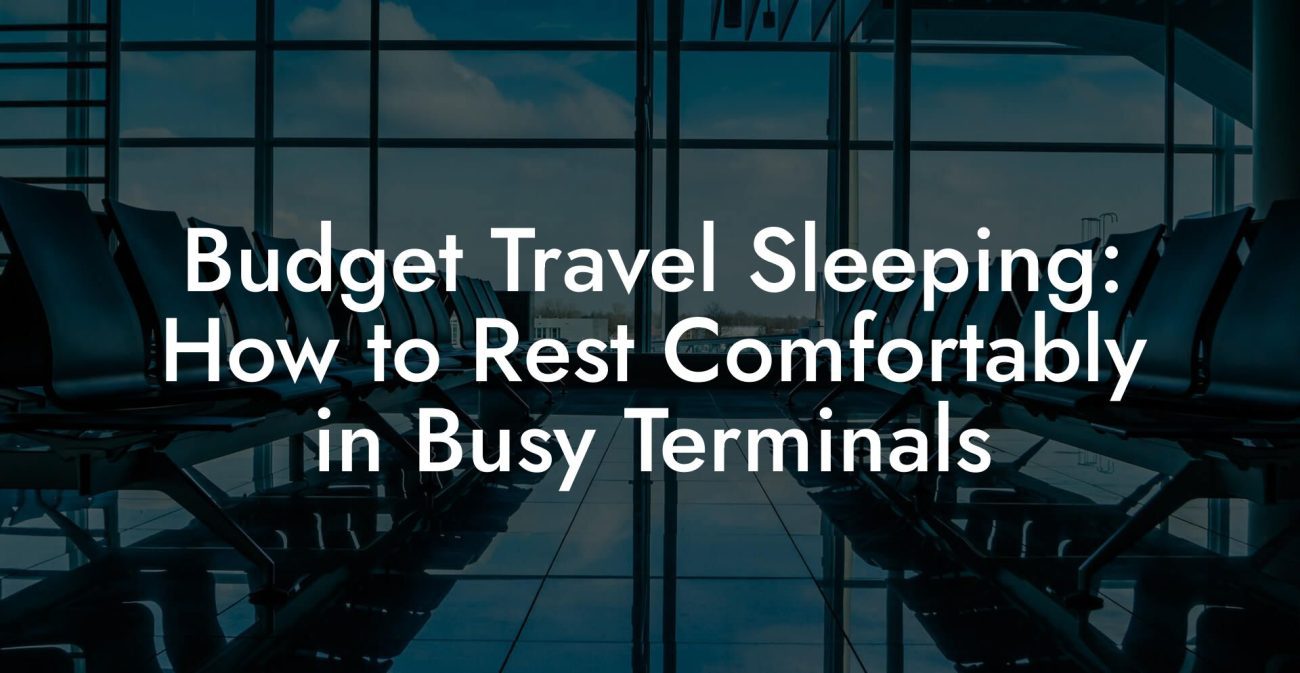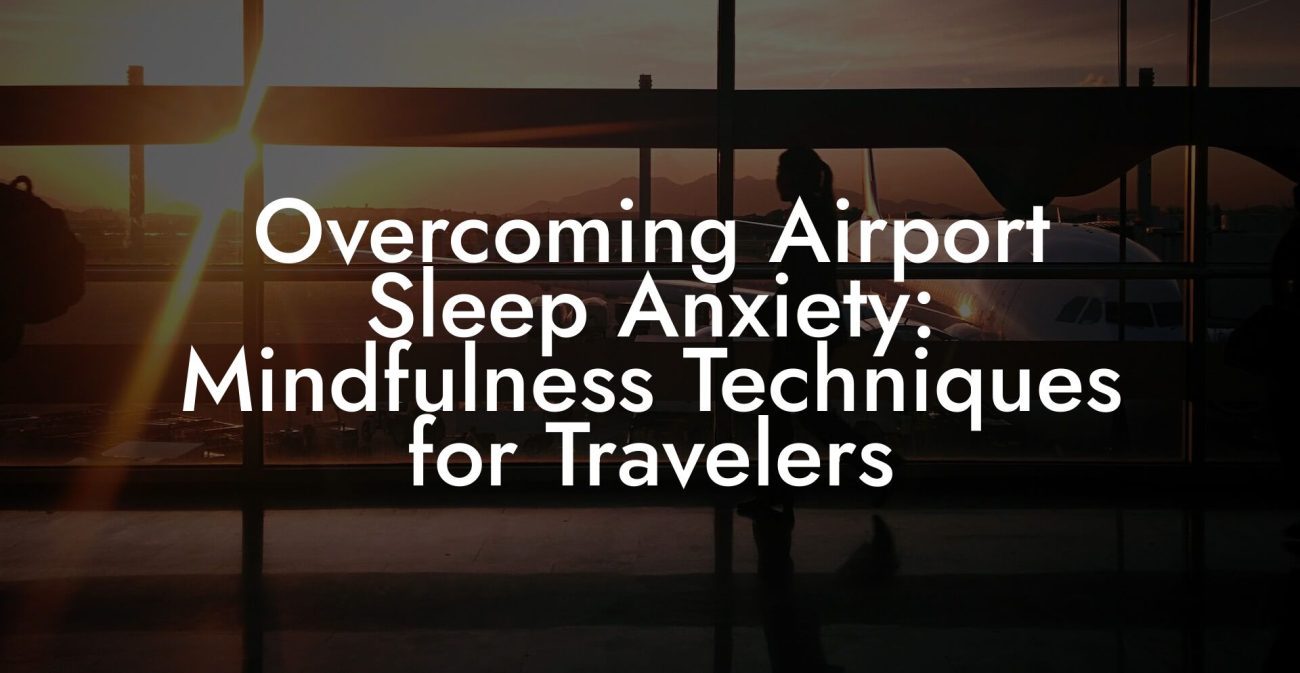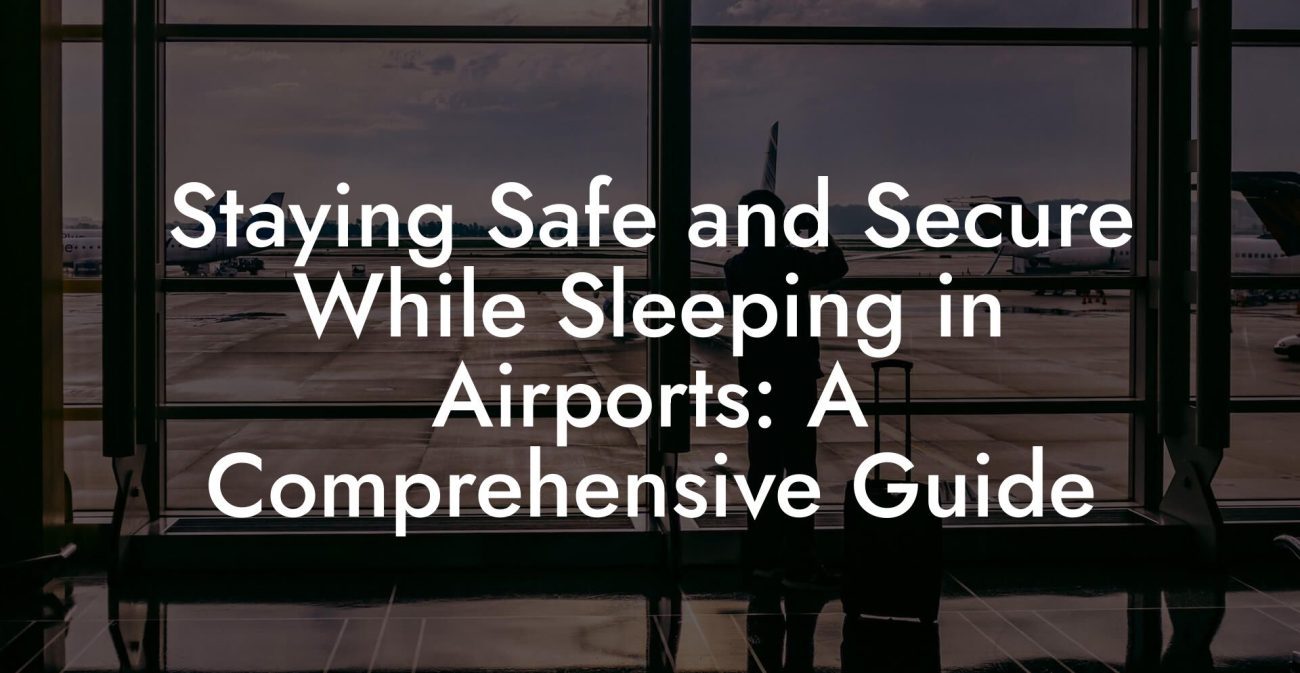Ever been on a red-eye flight wondering if your suitcase weighs more than your will to sleep? Jet lag is that uninvited travel buddy that makes time zones look like an unsolvable puzzle, and for the frequent flyer, it’s practically a lifestyle challenge. Dive into our no-nonsense guide “Beat Jet Lag: Sleep Strategies for the Frequent Flyer” and discover how to hack your way to better sleep on the go. Whether you’re squeezing in a nap at an airport pod or mastering the art of skipping restless flights, we’ve got the tips, tricks, and tech solutions to help you reclaim your sleep schedule and rock every new time zone like a boss.
Quick Links to Useful Sections
- Understanding Jet Lag: The Unwanted Travel Companion
- Sleep Strategies That Work: Beating Jet Lag One Nap at a Time
- Pre-Flight Preparations: Aligning Your Internal Clock
- Choosing the Right Flight: Timing Is Everything
- In-Flight Sleep Hacks: Transforming the Cabin into a Sleep Sanctuary
- The Art of Airport Sleeping: Mastering Those Terminal Naps
- Finding Your Perfect Spot: From Nap Zones to Secret Pods
- Airport Sleeping Pods: The Future of On-the-Go Rest
- Tips for a Successful Airport Sleep Session
- Tech and Gadgets: Enhancing Your Sleep on the Fly
- Sleep-Enhancing Gadgets You Can’t Travel Without
- Lifestyle Hacks: Pre-Flight Mindfulness and Sleep Rituals
- Mindfulness and Meditation on the Move
- Nutrition and Pre-Flight Rituals
- Setting the Scene: Pre-Sleep Environment Matters
- Personalized Strategies: Crafting Your Own Jet Lag Recovery Plan
- Step 1: Assess Your Current Sleep Habits
- Step 2: Map Out Your Travel Itinerary—and Adjust Accordingly
- Step 3: Incorporate Multi-Modal Sleep Enhancements
- Real-Life Jet Lag Victories: Stories from the Mile-High Club… of Nappers
- Story 1: The Digital Nomad Who Hacked Her Sleep Cycle
- Story 2: The Entrepreneur Who Turned Layovers into Luxury Time
- Story 3: The Frequent Flyer Family’s Quest for Rest Amid Adventure
- Resources and Community Support: Your Next Steps
- FAQ: Jet Lag and Sleep Strategies for the Frequent Flyer
- Your Journey to Jet Lag Freedom: Sleep, Reset, and Conquer
Understanding Jet Lag: The Unwanted Travel Companion
Jet lag is more than just a buzzkill—it’s a physiological disruption when your internal clock gets thrown off balance by rapid travel across multiple time zones. Your body’s natural circadian rhythm, which regulates your sleep-wake cycle, goes haywire when you leapfrog across the globe. This means you might feel groggy, disoriented, or even a bit out of sync long after you’ve landed.
For millennials and Gen-Z jet setters accustomed to a fast-paced life, the effects of jet lag can be particularly frustrating. Imagine trying to be productive in a new city, but your body is still stuck in “last night’s time zone.” The common symptoms—fatigue, insomnia, irritability, and digestive issues—can turn that much-anticipated adventure into a real-life zombie movie.
The good news? With the right strategies and a bit of planning, you can outsmart jet lag and give your circadian rhythm a much-needed reboot. In the paragraphs ahead, we’re breaking down everything from pre-flight sleep rituals to savvy hacks for catching ZZZs in unconventional airport nooks.
Sleep Strategies That Work: Beating Jet Lag One Nap at a Time
If jet lag had a nemesis, it would be a savvy traveler who’s mastered the art of strategic sleep. Here’s how you can prepare your body for time zone surgery and ensure that you’re not suffering from sleep deprivation halfway into your trip.
Pre-Flight Preparations: Aligning Your Internal Clock
Before you even step foot on the plane, take control and strategize your sleep. Start by gradually shifting your sleep schedule a few days before departure. If you’re traveling east, try going to bed an hour earlier each night; if west, push your bedtime later. This slow transition helps ease your body into the new rhythm.
Key Tip: Download a sleep tracker app to monitor your sleep trends in the days leading up to your flight. Apps like Sleep Cycle or AutoSleep can help you verify that your pre-trip adjustments are on target.
Choosing the Right Flight: Timing Is Everything
When booking your ticket, consider selecting flights that align with your natural sleep habits. Overnight flights, often dubbed “red-eye” flights, can be a blessing in disguise if you’re able to sleep on the plane. If you’re a light sleeper, though, you might prefer flying during the day and grabbing a power nap once you land.
Additionally, look for flights with fewer stops or layovers. Each takeoff and landing can disrupt your body’s equilibrium, making it even harder to settle into a sleep mode.
In-Flight Sleep Hacks: Transforming the Cabin into a Sleep Sanctuary
Once you’re airborne, it’s time to create your own little sleep oasis amid the cramped seats and recycled air. Here are some practical tips:
- Invest in a Quality Travel Pillow: A good travel pillow that supports your neck is non-negotiable. Memory foam pillows or inflatable ones with adjustable firmness work wonders.
- Noise-Cancelling Headphones or Earplugs: Eliminate the drone of the engines and chatty neighbors. Noise-cancelling headphones with a soothing playlist or simple earplugs can help create a cocoon of silence.
- Sleep Masks: Block out harsh cabin lights with a soft, contoured sleep mask. Your eyes—and your melatonin levels—will thank you.
- Dress Comfortably: Loose, breathable clothing can make a world of difference. Consider layering up for fluctuating cabin temperatures.
- Hydrate, Hydrate, Hydrate: Airplane air is delightfully dry, so drink plenty of water to keep your body lubricated and your energy humming.
Finally, consider a travel-friendly aromatherapy roll-on or a dab of lavender essential oil. A whiff of calming scent might just be the nudge your body needs into sleep mode.
The Art of Airport Sleeping: Mastering Those Terminal Naps
Let’s be real—airports aren’t typically known for their world-class sleeping accommodations. But for those times when your flight schedule or layover keeps you grounded, mastering the art of airport sleeping is essential.
Finding Your Perfect Spot: From Nap Zones to Secret Pods
Airport terminals are evolving, and many offer designated nap zones or quiet areas. Check the terminal map or ask staff if there’s a lounge or quiet room where you can catch some quality shuteye. Many modern airports now boast dedicated sleeping pods, complete with adjustable lighting and soundproofing.
If the airport lacks a dedicated sleeping space, scout out an unused gate, a tucked-away corridor, or even a carpeted seating area. Apps like “Sleep in Airports” and community sites like TripAdvisor often highlight lesser-known napping spots, giving you insider information before you travel.
Airport Sleeping Pods: The Future of On-the-Go Rest
For the frequent flyer who needs an upgrade from a bench nap, airport sleeping pods are a game-changer. These compact, futuristic spaces offer privacy, comfort, and a touch of luxury without the hefty price tag of a hotel room. They often come with features like adjustable beds, ambient lighting, and even integrated charging stations—talk about a productivity boost!
While these pods are a premium option and may require booking in advance, they represent the new frontier of travel sleep solutions. Travelers are raving about how easy it is to reset their sleep routine in a pod after a long-haul flight.
Tips for a Successful Airport Sleep Session
Whether you’re settling into a designated nap zone or snuggling into a cozy pod, keep these tips in mind:
- Keep Your Essentials Close: Secure your valuables and pack a small travel bag with a jacket, phone, and snacks. Many travelers use anti-theft pouches to maintain peace of mind.
- Set an Alarm: It’s easy to oversleep. Use your phone or a portable alarm clock to ensure you wake up in plenty of time to make your next flight or catch your connecting ride.
- Create a Personal Bubble: Personalize your space with a favorite scarf or travel blanket which can serve as both a comfort object and a visual cue that it’s time to rest.
- Mind the Time Zones: While trying to catch a nap, be aware of the local time to help adjust your circadian rhythm progressively. This small act can make a big difference later on.
- Embrace the Flexibility: Sometimes airport conditions aren’t ideal. Accept that your nap might be short and of varying quality. Even a power nap can work wonders if done right.
With these tips, you’ll be napping like a pro, turning the chaos of an airport into your own personal sleep haven.
Tech and Gadgets: Enhancing Your Sleep on the Fly
In an age dominated by smart devices and digital detox trends, tech-savvy travelers have an arsenal of gadgets designed to improve sleep quality—no matter where you are. From smart sleep masks to noise control devices, these modern tools are set to transform your travel sleep experience.
Sleep-Enhancing Gadgets You Can’t Travel Without
The modern jet setter’s toolkit now includes devices that actively monitor your sleep patterns and even interact with your environment. Here are some top picks:
- Smart Sleep Masks: These innovative masks not only block out light but can also produce gentle sounds or vibrations to guide you into a deep sleep state. Some models even sync with your phone to provide sleep analytics.
- Portable White Noise Machines: Perfect for drowning out the unpredictable sounds of airports or airplane cabins. Lightweight and rechargeable, these devices create a consistent ambient sound that soothes your mind.
- Wearable Sleep Trackers: Devices like smartwatches or fitness bands now come equipped with comprehensive sleep monitoring. They track sleep phases, heart rate, and even record disturbances, allowing you to fine-tune your in-flight sleep strategy.
- Travel Apps: There are countless apps available that not only monitor your sleep but also offer guided meditations, breathing exercises, and even DJ-curated lullabies perfectly tuned to help reset your internal clock.
Integrating these tools into your travel routine can make a noticeable difference. Technology isn’t just about convenience; it’s about creating an environment that lets you sync with your body’s sleep rhythms, regardless of where your journey takes you.
Lifestyle Hacks: Pre-Flight Mindfulness and Sleep Rituals
A jet setter’s life isn’t only about screaming through busy terminals and cramming on flights—the little rituals you build can pave the way for better sleep and less stress. Let’s talk lifestyle hacks for the frequent flyer.
Mindfulness and Meditation on the Move
Before, during, or after a flight, integrating mindfulness practices can help align your body and mind. Even a brief meditation session can lower stress hormones, making it easier to settle into sleep. Consider using apps like Calm or Headspace, which offer quick, travel-friendly meditations designed to center your thoughts and soothe your nerves.
Practice deep breathing exercises to calm your mind and prepare your body for sleep. A common method is the 4-7-8 breathing technique—inhale for 4 seconds, hold for 7 seconds, and exhale for 8 seconds. This not only reduces anxiety but also primes your body for a restful transition.
Nutrition and Pre-Flight Rituals
What you eat before and during your travel can dramatically affect your sleep quality. Stick to a balanced, anti-inflammatory diet in the days surrounding your flight. Foods rich in magnesium, such as leafy greens, nuts, and seeds, can help relax your muscles, while complex carbs promote serotonin production—your body’s natural sleep aid.
On long-haul flights, opt for light meals that are easy to digest. Avoid caffeine and heavy meals at least a few hours before your sleep time. Instead, try herbal teas like chamomile or valerian root tea, both known for their calming properties.
Setting the Scene: Pre-Sleep Environment Matters
Even on the go, you can create a bedtime ritual that signals to your body that it’s time to rest. Whether it’s dimming the lights in your hotel room, tucking yourself in with a familiar blanket, or playing soft ambient music, these small actions can have a significant impact. Establish a routine—even if it’s just 15 minutes—that you follow religiously before sleep. Consistency is key in fooling your body into thinking it’s bedtime.
Personalized Strategies: Crafting Your Own Jet Lag Recovery Plan
No two travel itineraries are the same, and neither are the ways our bodies handle jet lag. A personalized recovery plan is your secret weapon in turning every trip into a well-rested, productive, and enjoyable adventure.
Step 1: Assess Your Current Sleep Habits
Begin by tracking your sleep patterns over the course of a week. Identify when you naturally fall asleep and wake up, and note any disturbances in quality or duration. This baseline data helps you pinpoint what adjustments you need before undertaking long-distance travel.
Step 2: Map Out Your Travel Itinerary—and Adjust Accordingly
Once you know your sleep cycle, compare it against your travel schedule. Factor in how many time zones you’ll traverse and the expected flight durations. With this information, create a flexible schedule that includes strategic naps, exposure to daylight during key hours, and planned winding-down periods.
Step 3: Incorporate Multi-Modal Sleep Enhancements
Blend conventional sleep hygiene tips with modern technology:
- Set Alarms and Reminders: Use your smartphone to remind you when it’s time to wind down before a flight or when to engage in a pre-sleep ritual once you arrive at your destination.
- Create a Digital Sleep Journal: Tracking your progress helps you assess what’s working. Use apps or a simple diary to log sleep quality, mood, and energy levels day by day.
- Utilize Light Therapy: Exposure to bright light during the morning (or using a portable light therapy device) can help reset your internal clock faster by signaling to your body that it’s wake-up time.
Each of these tailored strategies adds up to a plan that’s as unique as you are. Keep refining it as you learn what makes your sleep tick (pun intended!).
Real-Life Jet Lag Victories: Stories from the Mile-High Club… of Nappers
Nothing fuels motivation quite like real-life success stories. From globetrotting influencers to business-savvy entrepreneurs, frequent flyers have turned jet lag into a manageable—and sometimes even laughable—part of modern travel.
Story 1: The Digital Nomad Who Hacked Her Sleep Cycle
Jasmine, a freelance graphic designer, was constantly hopping between time zones for client meetings. After battling exhaustion and missed deadlines, she embraced a hybrid approach: blending pre-flight meditation, strict in-flight sleep protocols, and occasional retreats in airport sleeping pods. “I hacked my sleep by treating it like any other project,” she explains. Today, Jasmine credits her improved creativity and productivity to mastering these sleep strategies.
Story 2: The Entrepreneur Who Turned Layovers into Luxury Time
Mark, a startup founder, used to dread layovers until he discovered the hidden gems of airport nap zones. By booking brief sessions in premium lounge pods and pairing them with quick power naps, Mark transformed his travel stress into an opportunity to recharge. His secret? Consistency and treating each layover like a mini-vacation—a practice that now sets the tone for his entire travel experience.
Story 3: The Frequent Flyer Family’s Quest for Rest Amid Adventure
For the Thompson family, traveling across continents used to mean sleepless nights and cranky mornings. But with a combination of tailored sleep routines, portable gadgets, and lessons learned from airport napping experiences, they turned chaos into calm. “We made our travel a family project in sleep transformation,” says Mrs. Thompson. Their story is a testament to how a proactive, humorous approach can make jet lag just another quirky aspect of travel.
These stories prove that with the right blend of planning, technology, and positive attitude, jet lag can be conquered. They serve as real-life blueprints, showing that sometimes the simplest tweaks can yield the most transformative results.
Resources and Community Support: Your Next Steps
Ready to take control of your travel sleep and join a community of globe-trotters who’ve cracked the code on jet lag? There are countless resources available online, from travel sleep blogs to dedicated forums where frequent flyers swap tips and success stories.
Explore curated sleep strategy apps, invest in travel tech gadgets, or simply connect with like-minded individuals on social platforms like Instagram, Reddit, or specialized travel communities. These networks are brimming with advice, honest product reviews, and firsthand accounts that resonate with your travel challenges—and victories.
Additionally, many airlines and premium airport lounges now feature sleep-centric facilities. Check with your favorite carriers about their latest sleep amenities and upcoming innovations in airport comfort. Stay connected through newsletters and blogs that focus on travel wellness for insider tips and bonus resources.
Your journey to better sleep while traveling starts by tapping into these networks. Whether you’re searching for the best sleeping pods or on the hunt for the perfect travel pillow, community support can help bridge the gap between restless flights and rejuvenating sleep.
FAQ: Jet Lag and Sleep Strategies for the Frequent Flyer
Got questions? Here are some of the most burning questions about jet lag, airport sleeping, and sleep strategies for travelers answered just for you.
1. What exactly is jet lag, and how does it affect my sleep?
Jet lag is caused by your body’s internal clock getting thrown off balance when traveling across multiple time zones. This disruption can lead to insomnia, daytime fatigue, digestive issues, and overall disorientation.
2. How can I adjust my sleep schedule before a long-haul flight?
Gradually shift your sleep hours by an hour or so in the days leading up to your flight. Use sleep-tracking apps, limit screen time before bed, and follow a consistent bedtime routine to ease into your new schedule.
3. What are some must-have gadgets to improve in-flight sleep?
Essential gadgets include a quality travel pillow, noise-cancelling headphones or earplugs, a sleep mask, and even smart sleep masks or portable white noise machines that create a soothing environment.
4. Are airport sleeping pods worth the investment?
For frequent flyers, airport sleeping pods offer a private, controlled environment to catch quality rest during long layovers. They often come equipped with features tailored for a sound sleep—definitely worth considering if you value your rest.
5. What lifestyle changes can help reduce the impact of jet lag?
Incorporate pre-flight sleep routines, mindful meditation, balanced nutrition, and light exposure therapy into your regimen. Small changes in your daily routine can have a big impact on how quickly your body adapts to a new time zone.
6. How can I sleep better if I’m stuck in a busy airport?
Look for designated quiet areas or nap zones in the terminal. If those aren’t available, use a travel pillow, noise cancellation tools, and a sleep mask to create your own mini retreat anywhere in the airport—a power nap can work wonders.
7. Do in-flight exercises help reduce jet lag?
Absolutely. Simple stretching and mobility exercises during the flight can promote blood circulation, reduce stiffness, and enhance your overall sleep quality by ensuring your muscles aren’t tense when you try to rest.
8. How soon after landing should I try to adjust to the local time?
It’s best to expose yourself to as much natural sunlight as possible upon arrival. Try to stay awake until a normal bedtime according to local time, as this will help recalibrate your internal clock faster.
Embracing these sleep strategies and making the right lifestyle adjustments will help you beat jet lag and elevate your travel experiences—one restful nap at a time.
Your Journey to Jet Lag Freedom: Sleep, Reset, and Conquer
Being a frequent flyer means embracing the chaos of time zones while finding creative ways to stay well-rested. By integrating pre-flight adjustments, savvy in-flight hacks, and even leveraging the quiet corners of bustling airports, you empower yourself to beat jet lag and transform travel fatigue into an opportunity for mindful rejuvenation.
Whether you’re a digital nomad hopping between continents or a globe-trotter chasing the next adventure, the strategies outlined in this guide are designed to work with your busy schedule, not against it. Every quality sleep session, every peaceful nap in a sleep pod, and every mindful meditation aligns your body’s natural rhythm with your travel lifestyle.
Embrace the journey toward jet lag freedom with confidence. Adapt these techniques, customize your sleep strategy, and join a community of travelers who have transformed their travel experiences one power nap at a time. It’s time to reclaim your rest, sync your internal clock, and greet every destination feeling refreshed, reinvigorated, and ready for whatever adventure comes next.
So pack smart, sleep well, and let every journey be a testament to your new mantra: sleep, reset, and conquer!
Useful Interruption: Dive deeper into the world of airport sleeping guides with our most popular sections. If there is anything you think is missing or anything you would love for us to write about, just give us a shout.
- General Airport Sleeping Guides
- Travel Gear & Equipment Recommendations
- Regional and Airport-Specific Guides
- Airport Sleeping Pods & Reviews
- Health, Safety, and Comfort Tips for Airport Sleepers
Last week, I decided to try the world-famous "airport sleepover" experience. Imagine this: I'm lying on a bench in Terminal C, surrounded by suitcases that have seen more of the world than I ever will, and a PA system that sounds like a karaoke machine on a sugar rush. I pull out my travel pillow—which, by the way, is more like a sad deflated balloon—and declare, "Tonight, I’m the king of this terminal!"
Soon enough, fellow travelers become my unexpected audience. One guy, fresh off a red-eye, whispers, "Hey, do you think if we sleep long enough, we can catch our flight in our dreams?" I reply, "Sure, and maybe I'll even get an upgrade to first-class in my nap!" The airport lights flicker like a disco ball, and every time someone announces a delayed departure, it’s like a punchline to our impromptu stand-up routine.
As I finally drift off, I dream of a world where boarding passes are like VIP tickets to the best sleepover party ever—a party where the only baggage is the laughter you carry with you. Waking up, I realize the airport is still the same, but I now hold the honorary title of "Terminal Comedian," a title I wear with as much pride as my permanently mismatched socks!










